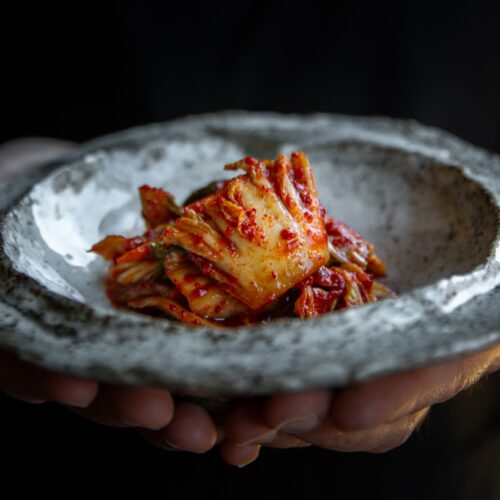
Best Vegan Kimchi
A delicious and easy to follow vegan kimchi recipe.
Equipment
- One 16 qt colander
- 1 blender or food processor
- 1 small saucepan
- Two 32 ounce mason jars (or 4 to 5 smaller mason jars)
Ingredients
- 2 1/2 cup kimchi salt (can substitute coarse sea salt)
- 2 heads Napa cabbage (~ 4 pounds)
- 1/4 cup glutinous rice flour
- 1 1/2 cup rough chopped apple
- 1/2 cup rough chopped onion
- 1/2 cup rough chopped scallion whites
- 1/2 cup garlic cloves
- 1 thumb ginger
- 1/2 cup vegan fish sauce (can substitute store bought vegan fish sauce or soy sauce)
- 1/4 cup plum syrup (can substitute brown rice syrup, maple syrup, sugar)
- 2 cups julienned carrot
- 2 cups scallion greens, chopped into 2-inch pieces
- 2 cups daikon radish, sliced and cut into 1/4-inch thick pieces
- 3 cups gochugaru
Instructions
Salting the Cabbage.
- Add 1 cup of salt to 6 cups of water. Stir and set aside until the salt dissolves. Remove any heavy stubs on the ends of your cabbage heads. Then, using a sharp knife, create a 2-inch slit down the middle of the root end or “butt” of the cabbage heads.
- Then, using your hands (utilizing your hands to split the cabbage heads will partially preserve the delicate and natural shape of the leaves) split each cabbage head in half. Repeat with each cabbage half to create quarters. Cut the cabbage quarters into large, bite-sized chunks (like you would for a salad).
- Place one quarter of the cabbage pieces into a very large bowl. Sprinkle with a quarter of the salt, then pour a quarter of the salt water over the cabbage. Repeat with the remaining cabbage, salt and salt water. Set aside until the cabbage leaves begin to wilt (around 90 minutes to 2 hours). You will know they are ready for the “midway flip” when they are pretty bendy. Using your hands, flip the cabbage leaves so that the ones resting at the bottom of your bowl are now on top and vice versa.
- Set aside until the cabbage leaves are very wilted and quite salty, at least 90 minutes but up to 4 hours, depending on the thickness of the cabbage leaves. You can test that your cabbage is ready for saucing by taking a piece from the thickest part of the cabbage leaf (I.e., right by the “butt”) and checking to see that it bends quite easily without breaking. Then, give it a good rinse before tasting it—if it tastes VERY salty (you’ll think too salty), it’s ready. Once your cabbage leaves are sufficiently wilted and salty, drain all of the excess water and rinse the leaves thoroughly with cold water.
Saucing the Cabbage.
- To make the sauce, prepare the rice “glue” by adding the sweet white rice flour with 1 1/2 cup of water in a small pot over medium heat. Use a whisk to stir the mixture continuously until it turns into a thick glue-like consistency (about 3 minutes). Set the “glue” aside and allow it to cool.
- Meanwhile, place the apple, onion, scallion whites, garlic, ginger and plum syrup into a blender and blend on high until smooth (about 1 minute). Mix together the rice glue, the blended garlic mixture, scallion greens, carrot, daikon, Fishy Sauce and gochugaru.
- Pour the sauce over the rinsed cabbage leaves. Using your hands (wear gloves!), spread the mixture over the cabbage leaves to makes sure they are evenly and well coated. Place the kimchi into airtight containers (I use two 32-ounce mason jars), pressing down with each scoopful to remove air pockets. If you have a lot of space left at the top, sprinkle with a handful of salt (this will prevent the growth of any yeast).
- Store the kimchi at room temperature for the first 24 hours. Then place in the refrigerator. Your kimchi will be ready to enjoy by the third or fourth day, though it will mature and taste even better if you wait a couple weeks.
Tried this recipe?Let us know how it was!